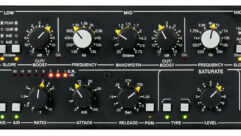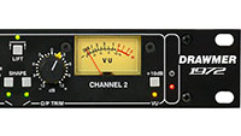
Drawmer DSL424
Sep 1, 2005 12:00 PM,
By John McJunkin
Gating and compression/limiting in a single, high-quality package.
It’s no secret that Drawmer has given us some very fine dynamics processors over the years, including the classic 1960, and I’ll let you in on the secret: The company has always made my favorite gates. The newest addition to its product line combines both compression/limiting and gates. The Drawmer DSL424 provides two channels of high-quality compression/limiting and two channels of Drawmer’s excellent gates. I was very excited to have one of these units arrive on my doorstep for review. I immediately unboxed it and dived right in. Here’s what I found.
THE HARDWARE
From left to right across the front panel of the DSL424 are two gates and two compressor/limiters. The gates can be side-chained, and the key source can be filtered with onboard high- and low-pass filters. Each gate also has threshold level and release time knobs. There are switches to toggle between internal and external key sources, to switch between key listen, output, and bypass modes, and pushbuttons to toggle between hard and soft gating and to increase the gate’s range from -20dB to -90dB. One last pushbutton allows the linking of both gates. Drawmer’s famous traffic-light display indicates whether the gate is open, closed, or in hold time.
Each compressor features knobs for threshold level, ratio, and make-up gain. Also, pushbutton switches toggle between soft- and hard-knee compression, allow bypass, and also link the two channels. The peak limiter simply features a level knob, which literally determines the maximum output level. Separate LED meters display gain reduction and output level, and a single peak LED indicates when the limiter is engaged.
The input/output topology of the DSL424 is such that each processor is a discrete unit. This enables maximum flexibility in terms of signal flow configuration. For live applications, a two-channel serial gate/compressor is the obvious configuration. In the studio, it’s nice to have two discrete gates and two discrete compressors at the ready, although the compressor/gate pair is again a likely configuration, particularly at mixdown. The unit’s signal I/O is all balanced XLR with the exception of the external key inputs, which are 1/4in. inputs.
TEST DRIVE
I sent a number of signals through the unit to get a handle on the audio quality, and I discovered that this is a truly professional tool. Although I’ve had prior experience with Drawmer’s gates, I have really encountered its compressors only in passing, so I was excited to have a test drive. As it turns out, the compressors exhibit the typical high quality expected from Drawmer. By tweaking threshold and ratio, which ranges from 1.2:1 to infinity:1, it’s possible to get anything from smooth, mastering-type level control to full-on punch. And although the unit lacks control over attack and decay times, the hard-knee/soft-knee switch gives two options in terms of the aggressiveness of the compression, and it eliminates the need for a lot of futzing. Obviously, there are applications that require user adjustment to attack and decay times, but for get-it-done applications in which you need to simply gain control over level, this unit not only simplifies the process, but it also gives you excellent quality at the same time.
And please don’t misunderstand me about the lack of attack and decay controls. By working with the available controls, it’s possible to achieve a full spectrum of results, from smoothing the overall level of a mix to pumping effects for percussion or other transient signals. By overdriving a bit, it’s even possible to put a bit of hair on the signal, the pleasant kind of distortion that adds some character to a rock vocal or guitar track. Even at extreme peak limiting, however, the dynamics processing is relatively subtle. At more moderate settings, the compression is very transparent. The unit can be coaxed to pump, but its natural state is smooth level control. These are multiple-use compressors that I could imagine myself using for many different applications.
I must admit a bit of bias here — namely that Drawmer’s gates have always been my favorites, for a couple of reasons. One is that they simply sound great. Whether I’m chopping something up for effect or cleaning up a tom-tom track, these units have always given me clean, artifact-free gating. The other reason I love these gates so much is Drawmer’s legendary traffic-light display, which is eminently helpful not only in arriving at appropriate setting of the threshold level and release times, but also in indicatiing what’s going on while I mix. The unit’s key source filters exhibit a slope of 12dB/octave, and having these filters is tremendously handy because they give you a lot of control over the side-chain process. Among other things, this easily enables the user to accomplish some specialized configurations, such as keying a bass guitar to a kick drum. Another simplification here is the range switch. While many gates make the range continuously variable, Drawmer simplifies with the -20dB/-90dB range switch. For most users, this is adequate control. Either the user will want full-on, drop-it-out-of-audibility gating, or for applications that require a bit more subtlety, such as vocals, the -20dB setting is perfect. Similarly, the hard/soft gating switch determines slew rate and provides adequate control for most applications. In hard mode, the gate is very fast — useful for transient signals or special effects — while the soft mode slows down the slew rate a bit, virtually making the unit an expander. In test-driving these gates, I was reminded why I love Drawmer gates to begin with — very clean, accurate controls, and equally adept at wild effects as they are at cleaning up drum tracks.
CONCLUSION
At the end of the day, I am most impressed with the DSL424. This is a very high-quality unit that gives simplified control over signal dynamics. I took a look at the throughput with SIA Smaart’s transfer function display and discovered that what goes in is what comes out from a spectral and phase standpoint. The throughput is very much linear in that way. As to what the box is supposed to do, it accomplishes the goal very nicely. The level control is very smooth and transparent, to the extent that you really have to force the unit to do anything to the contrary. It takes a little work to make this thing pump. But that’s nice as well, to know that you can have both ends of the spectrum. The gates (once again, my admitted favorites) are powerful tools, but now I’m also delighted with the quality of the compressors as well. To get two of each in a single box is a dream come true.
PRODUCT SUMMARY
Company: Drawmer Electronics www.drawmer.com
Product: DSL424
Pros: High-quality, no-muss dynamics processing; four discrete processors.
Cons: None.
Applications: Studio and live sound applications requiring high-quality, easy-to-use gating and compression limiting.
Price: $1,460
SPECIFICATIONS
Input Impedance (all inputs) 20kΩ
Maximum Input Level (all inputs) +21dBu
Output Impedance (all outputs) 50Ω
Gate Channel
Bandwidth <10Hz to 22kHz ±1dB
Floor Level -90dB (switchable to -20dB)
Noise -99dB RMS (IEC A-weighted)
Distortion <0.04%, gate open with +4dB input
Compressor Channel
Bandwidth <12Hz to 35kHz ±1dB
Crosstalk >-80dB @ 10kHz, >-75dB @ 20kHz
Output Balance >40dB, 20Hz-10kHz
Noise -98dB RMS (IEC A-weighted)
Distortion <.02%@100Hz, <.015%@1kHz, <.035%@10kHz, unity gain, +4dB input
John McJunkinis the principal of Avalon Studio Service in Phoenix and consults for both studios and live sound applications.










